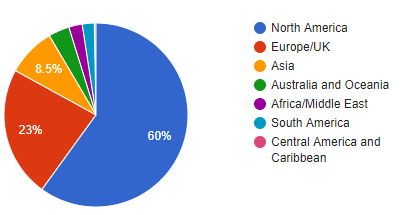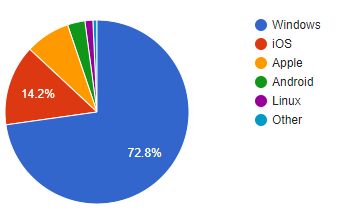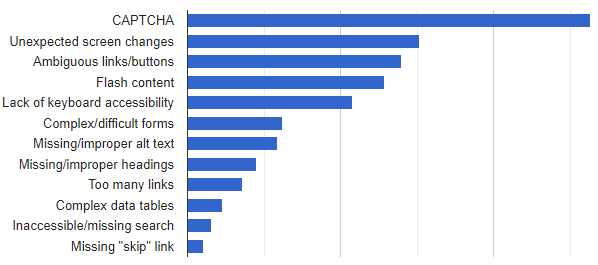0LAUK0 PRE2018 3 Group 13 User Research
Introduction
This page contains the user research performed by group 13 for the course Project Robots Everywhere (0LAUK0). Here we summarize the results of our own surveys as well as those that are available online. Using this information, we determine the desired functionality and set corresponding user requirements.
Summary
Survey results
The following survey results are taken out of the reference source and only contains information relevant to our case. As of such, in order to view the entire full survey, we recommend you to look at the reference link.
3. Screen Reader User Survey looked into the preferences of screen reader users. They have received 1792 valid responses and it was a follow-up to six previous surveys conducted between January 2009 and July 2015.
3.1 Over 95% of the responses indicate that they suffer from blindness or visual-impairment. As of such, their opinions are relevant to us.
3.2 A strong majority shows that they primarily use the Windows operating system and a lot use the Apple's OS. Only a very small percentage use lesser common systems like Linux or others.
3.3 The survey asked respondents to select their most, second most and third most problematic items from a list. In giving each selected item a weighting, the following chart shows the overall rating of difficulty and frustration for each item.
Most of these items are either simply constraints to blind people or cause unexpected visual changes. Either way they relies on visual perception and create an understanding problem to blind users.
4. Braille Reader Survey Analysis 1983 by Government Studies & Systems Philadelphia is an old survey, but we mainly look at the results of reading braille on paper and their opinions which can still be applicable nowadays. There is a total of 240 responses and we summarized the result count in percentages.
4.1 Are you:
- 40% Male
- 60% Female
4.2 Age in years at your last birthday:
- 1% < 15
- 7% 15 - 24
- 38% 25-39
- 39% 40-64
- 15% > 65
4.3 Would you describe your ability to read braille as:
- 58% Excellent
- 33% Good
- 8% Fair
- 1% Poor
4.4 At what age did you begin to read braille?
- 82% < 18
- 9% 19 - 34
- 6% 35-54
- 3% > 55
4.5 In which way do you read most frequently?
- 52% Braille
- 42% Audio
4.6 If all reading material could be in the format of your choice, in which way would you prefer to read?
- 68% Braille
- 32% Audio
4.7 Do you think the quality of braille dots in press braille books is:
- 39% Excellent
- 50% Good
- 11% Satisfactory
- 0% Poor
4.8 "Thermoformed materials" are single-sided plastic copies of hand-transcribed paper masters. "Paper materials" may be single- or double-sided paper copies of braille materials. Do you find thermoformed reading materials:
- 27% Same as paper materials
- 54% Less pleasant to use than paper
- 7% More pleasant to use than paper
- 12% Have never used thermoformed materials
4.9 Some braille books are now produced on paper and some on thermoform plastic. Would you be willing to accept considerably fewer braille titles in order to have books produced only on paper?
- 16% Yes
- 64% No
- 20% It does not matter
5. Use of braille display survey asks several blind people about their life and experiences with different braille displays. Their names have been changed to protect privacy.
5.1 Steve – Work user
- Steve, aged 31-45, has been using braille displays for 10 years. He currently uses an 80-cell braille display attached to his work computer. This display is funded through Access to Work
- Steve prefers to use his braille display to read long documents as he finds he sometimes loses concentration listening to the speech on his computer.
- Steve uses his braille display alongside a JAWS screen reader to help him in his job as an administrator. He thinks using both tools together makes him more efficient:
"I don't use it constantly […] I use it as a checking and orientation device […] It’s a mixture of using the voice and the braille display together to speed things up. So I'm looking at the braille display with one hand, listening and flicking keys with the other […] Keyboard and braille display and JAWS reading together helps you do things a lot faster."
- Steve considers his braille display as a work tool, and would not like to use it for leisure reading:
"I like to relax with a book, so I want to be sat slumped or on a train, I wouldn't want to have a piece of hardware on my knee. I don't mind sitting with a book because I can fall asleep and if it falls on the floor and I'm not chucking a thousand pounds on the floor!"
- Despite finding his braille display very useful in his job, Steve would not buy one for himself.
"The prices are phenomenally high and I don't understand why they have to be […] they don't seem to be aimed at the home user, the individual. I'd spend my money on a good holiday before I ever thought about getting a braille display. I'm quite happy to work without one at home."
5.2 Roger - Leisure user
- Roger, aged 65-74, uses two braille displays, both of which he owns
- Roger uses a notetaker device with a 32-cell braille display. This is a portable device, which Roger uses for his diary, addresses and database.
"I carry it around, take it away with me. It's got all the information that I need to hand with speech and braille."
- Braille is not Roger's preferred format, but he sees the braille display as offering backup to speech software. He also finds refreshable braille easier to read than hard-copy braille:
"I am partially deaf, and so I use my braille display if I need to use the computer as a support to speech… I didn't learn braille until later in life, so I'm very slow […]. It took me a long time to learn braille and one of the biggest problems […] was keeping your finger in the same line when there was hardly a gap between the lines. [When] you've just got a line you've got nothing above it nothing below, it makes life much easier."
5.3 Karen – work and leisure user
- Karen, aged 31-45, is deaf blind. Karen has been using a braille display for 16 years. She uses 3 braille displays, two of which she owns, and the other is funded through Access to Work. Her braille displays include a display which can be attached to a computer or mobile phone and a notetaker device.
- Each of Karen's braille displays has 40 cells. The devices differ in their size and weight and the comfort of using them:
"The dots are maybe a fraction smaller, which I prefer. Also the position of the buttons is preferable. […] I find having [the buttons] on the front means I have to keep bending my wrists a tiny bit which can make them a bit sore if I do it too much without a break."
- Braille is Karen's preferred reading format, although she prefers using hard-copy. Using the braille display is the only way Karen accesses her computer:
"I generally prefer having things in hard-copy braille, especially if it is something I'm reading for leisure. But most of the time I don't have that luxury, so my braille display is essential for anything I don't have in hardcopy. I can't use speech at all."
References
Group 13 survey results
1. https://drive.google.com/file/d/1a6CgYqBcHCB3pD2HzhYHlJ-2P9snBcFE/view?usp=sharing
2. https://drive.google.com/file/d/1-KIIQkl0nYmRsft4FWjfrHaNySzV_B5I/view?usp=sharing
Online survey results
3. Screen Reader User Survey #7 Results. WebAIM, October 2017. Available at: https://webaim.org/projects/screenreadersurvey7/
4. Braille Reader Survey Analysis. Government Studies & Systems Philadelphia, 1983. Available at: https://archive.org/details/braillereadersur00gove
5. Cryer, H., and Home, S. (2011). Use of braille displays. RNIB Centre for Accessible Information, Birmingham: Research report #15. Available at: https://www.rnib.org.uk/sites/default/files/2011_06_Use_of_braille_displays.doc
6.


